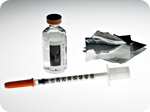
The Diabetes Wake-Up Call and How to Avoid Diabetes
Thursday, April 17, 2008 by: Leigh Erin Connealy, M.D.
Tags: preventing diabetes, health news, Natural News
- Newly released JFK files reveal Pentagon's role in creating Lyme disease and covid in the same lab
- Here are TEN all-natural ways to protect your garden without using harmful chemicals
- Ginseng's hidden anti-aging power: How compound K is rewriting the rules of skincare
- “Endgame: The Hidden Agenda 21” unveils a world of conspiracy and control
- L.A.'s rebuilding nightmare: Only 4 permits issued after fire destroys 6,000 homes
- Scientists demand FDA withdraw mRNA COVID vaccines amid contamination and gene therapy concerns
- Senate Democrats deny censorship industrial complex existed, defend government's role in silencing dissent
- “The shame of Minnesota”: Somali immigrants behind $250 million child nutrition fraud in largest COVID-era scam
- Former Congresswoman exposes CCP's deep infiltration of California through universities, ports, and fentanyl
- Dr. Suzanne Humphries makes bombshell appearance on Joe Rogan podcast, exposing vaccine industry deception back to POLIOMYELITIS
- PROCESSED TABLE SALT in foods found to fuel depression
- Despite surge in MMR vaccination in Texas, measles outbreaks continue: Is VACCINE SHEDDING fueling the spread?
- Chewing gum's dirty secret: How your daily habit could be flooding your body with microplastics
- “Independent” anti-Russia outlet MEDUZA faces COLLAPSE as US funding dries up
- BPA: The hidden hormone disruptor sabotaging your health - and how to fight back
- Embracing the wild: A deep dive into Jim Cobb’s “Backwoods Survival Guide”
- The hidden battle in your glass: How A1 and A2 milk could shape your health
- Nomi Prins reveals how central bankers reshaped the global economy in “Collusion”
- Newly released JFK files reveal Pentagon's role in creating Lyme disease and covid in the same lab
- Analysis: The coming economic collapse, a mass uprising and Trump's three secret weapons to halt the growing revolt
- Festive flavors: The sweet history, nutritional profile and health benefits of pecan pie
- Elon Musk: Aliens could be here on Earth RIGHT NOW
- Trump reverses course on Gaza plan, says “nobody is expelling Palestinians”
- Big Pharma's $8 Billion bribery scheme exposed: how doctors are pushed to prescribe junk science, not heal
- Boys are back in town: Trump’s patriotic alpha crew takes the wheel while toxic females ride in the backseat
- Reclaim your health: How midlife exercise reverses years of inactivity
- A lack of integrity in Academia: Harvard professor found GUILTY of fraudulent research to promote CRT theory
- Survival 101: Effective EMF blocking techniques
- EPA advisor admits the agency is funneling billions to climate groups ahead of Trump’s return to White House
- Dr. Mike Yeadon releases 15-minute testimony - WATCH - about genocidal intent of COVID “vaccines”
- 5 Simple steps to boost your brainpower: How to strengthen executive function in a distracted world
- Florida takes a stand: DeSantis proposes permanent ban on mRNA vaccine mandates
- Sugarcane extract superior to cholesterol-lowering drugs?
- Mike Adams Sermon 66: God will DESTROY ISRAEL for its wickedness
- Pilots report mysterious lights 'moving at extreme speeds' across Oregon skies
- Space war brewing? Russia threatens to destroy Starlink satellites
- EPA advisor admits the agency is funneling billions to climate groups ahead of Trump’s return to White House
- California's social media censorship law struck down: A victory for free speech or a threat to online safety?
- The Health Ranger releases “Vaccine Zombie” song and music video, using AI-animated zombies for the music video
- Dr. Mike Yeadon releases 15-minute testimony - WATCH - about genocidal intent of COVID “vaccines”
- The pandemic as a tool for INDOCTRINATION: Understanding “The Indoctrinated Brain” by Dr. Michael Nehls
- Newly released JFK files reveal Pentagon's role in creating Lyme disease and covid in the same lab
- Florida takes a stand: DeSantis proposes permanent ban on mRNA vaccine mandates
- Mike Adams releases country western hit single: Goin’ Back in Time is Comin’ Home
- Mike Adams releases music poetry sensation: A Child of God
- “Why we influenced the 2020 elections”: Facebook files reveal the coordinated effort to bury the Hunter Biden laptop story
- Unpacking the Lies That We’ve Been Fed – new song and music video released by Mike Adams, the Health Ranger
- RFK Jr. clears key hurdle: Sen. Susan Collins backs controversial HHS nominee, signaling a new era for health policy
- Mike Adams releases new song and music video: Nothing More Disgusting Than a Globalist
- Michigan sheriff announces criminal investigation into 2020 election crimes, Dominion Voting Systems
- Israeli soldiers accused of even more torture and abuse in the West Bank
- Migrants are taking advantage of recent hurricanes to scam residents and loot their homes
- House Intelligence Committee calls for the ARREST and PROSECUTION of Dr. Anthony Fauci
- Rep. Nancy Mace introduces bill to ban biological males from female facilities on federal property
- Red Cross issues warning to stop blood plasma donations from vaccinated people
- Scientists confirm: GENIUS brain function can be spontaneously unleashed in humans without any apparent cause
- EPA advisor admits the agency is funneling billions to climate groups ahead of Trump’s return to White House
- HYSSOP: What research reveals about the health benefits of this ancient holy herb
- Two containers with completed ballots fall out of truck in Florida
- Fully vaccinated about to see “tsunami” of illness and death, warns virologist
- Global leaders unite to clamp down on “misinformation” with UN-backed Cascais Declaration
- BREAKING: 2025 NDAA authorizes mandatory military draft of WOMEN across America… as Pentagon pursues global NUCLEAR war with both Russia and China at the same time
- Michael Yon warns of a ZIONIST TAKEOVER in Trump’s second administration
- BOMBSHELL: DNA testing kits are a SCAM to develop ethnic-specific bioweapons
- Ozempic and Wegovy weight loss drugs are injectable LIZARD VENOM PEPTIDES that may unleash a devastating wave of organ failure… side effects align with symptoms of SNAKE BITES
- Israeli soldiers accused of even more torture and abuse in the West Bank
- These 13 countries just signed an agreement to engineer a global FAMINE by destroying food supply
- NASA admits that climate change occurs because of changes in Earth’s solar orbit, and NOT because of SUVs and fossil fuels
- RFK Jr. clears key hurdle: Sen. Susan Collins backs controversial HHS nominee, signaling a new era for health policy
- Sermon 30: How Jesus reveals Caesar’s FAKE CURRENCY and FALSE AUTHORITY
- Coriander seeds: Ancient medicine backed by modern science
- Arizona officials claim Maricopa County needs 10-13 days to tabulate results of the election
Diabetes is a chronic health problem stemming from elevated blood sugar (glucose) levels. Glucose is a simple sugar that our bodies derive from the foods that we eat. The body's metabolism of carbohydrates, proteins and fats leads directly to the production of glucose, which enters the bloodstream after a meal and is the necessary nutrient to provide energy to every cell in the body. When too much glucose is present in the bloodstream, diabetes results.
Glucose levels become elevated when the glucose is unable to enter the cells in the bloodstream. Imagine that your bloodstream is a highway and each cell in the bloodstream is a car. Cars need gasoline (glucose) in order to run, and these cars within your bloodstream require a key to unlock the gas cap before the tank can be filled. In your body, this key is insulin. Without insulin the glucose cannot get into the cells and it is left to float freely through the bloodstream. Just as a car without gasoline will eventually fail to run, your body will begin to suffer without glucose.
In the case of type 2 diabetes, it's as if someone has changed the locks on the gas cap. The cells fail to recognize the insulin and deny entrance to the glucose. That's what we call insulin resistance.
There are two different tests that can be used to determine if a person has diabetes. Each test measures the patient's blood glucose levels after a period of fasting and then determines if the patient is in the normal, pre-diabetic or diabetic range. A normal test result indicates that the body is processing glucose properly, where as a diabetic test result indicates that the body is resisting insulin and too much glucose is present in the bloodstream. A pre-diabetes test score falls short of the lower threshold for diabetes yet still indicates an elevated presence of glucose in the bloodstream. Being diagnosed with pre-diabetes is a powerful wake-up call that should not be ignored.
Type 2 diabetes can eventually lead to serious health complications and it is estimated that 2 out of 3 people with diabetes will die from heart disease or stroke. Research has shown that the type of long-term damage that typically occurs in those with diabetes can actually begin during pre-diabetes. The elevated blood glucose levels associated with pre-diabetes can increase your risk of cardiovascular disease by 50% over those who have normal blood glucose levels.
Fortunately, a study published in the New England Journal of Medicine in February of 2002 has provided hope for those living with pre-diabetes. The Diabetes Prevention Program Study showed that just 30 minutes a day of moderate physical activity, coupled with a 5-10% reduction in body weight, produced a 58% reduction in diabetes for those already diagnosed with pre-diabetes. The researchers believe that weight loss reduces the risk of diabetes by improving the ability of the body to use insulin and process glucose.
When it comes to physical activity the American Diabetes Association recommends that people with pre-diabetes or diabetes should aim for a minimum of 30 minutes most days. Physical activity can consist of walking, gardening, doing yard work, swimming or cleaning the house. According to the ADA, beneficial physical activity can be, "anything that increases your heart rate and causes you to break a sweat." Don't worry, however, if 30 minutes seem overwhelming at first. Breaking up activities into 3 10-minute intervals a day is a great way to achieve the desired 30 minutes.
Healthy eating is an important component to any weight loss plan and often times can seem overwhelming. Keep in mind that there is no one perfect food so it is important to eat a wide variety of foods including vegetables, whole grains, fruits, non-fat dairy products, beans and lean meats, poultry and fish. The key is to regulate portion sizes while lowering your fat and caloric intake.
I highly recommend consulting with your doctor as well as a nutritionist before making any major lifestyle changes. Your overall health should be factored into any exercise and healthy eating plan to prevent the possibility of causing more harm than good. Additionally, allowing a certified nutritionist to guide you through the often confusing world of healthy eating will not only provide you with valued support but can also boost your chances of success.
A diagnosis of pre-diabetes is an opportunity to take your health into your own hands and make changes for the better. By incorporating physical activities, healthy eating and taking the right supplements into your life you are not only taking steps to avoid diabetes but you are improving your overall health and reducing your risk of cardiovascular disease as well. If you or someone you know is one of the 25% with pre-diabetes, seize this opportunity to make a detour on the road to diabetes! I also recommend perfectlyhealthy Metabolic Rx for pre diabetes symptoms which includes chromium including the perfectlyhealthy Mega Greens plus MSM and pH Plus! Together with the proper diet and exercise, these supplements can help!
About the author
Leigh Erin Connealy, M.D. has specialized in Integrative Medicine for over twenty years, using conventional and natural methods to determine and discover the "root of the cause" in her clinic, Center for New Medicine in Irvine, California, each and every day. Many people come in to the clinic from all over the world with severe chronic illnesses that conventional medical protocols have been unsuccessful treating. She realized early on that she can truly change lives through education as well as treatment protocols.Leigh Erin Connealy, M.D. and her medical staff strives to look at the whole person while exploring the effects and relationships among nutrition, psychological and social factors, environmental effects and personal attunement. Out of frustration of trying to find the right products to help her patients she formulated the perfectlyhealthy brand of products. All perfectlyhealthy products are clinically tested. For more information on recommended products, please visit www.perfectlyhealthy.net or www.perfectlyhealthy.com.
Preventing diabetes at FETCH.news
Get independent news alerts on natural cures, food lab tests, cannabis medicine, science, robotics, drones, privacy and more.
Take Action: Support Natural News by linking to this article from your website
Permalink to this article:
Embed article link: (copy HTML code below):
Reprinting this article:
Non-commercial use OK, cite NaturalNews.com with clickable link.
Follow Natural News on Facebook, Twitter, Google Plus, and Pinterest
Science News & Studies
Medicine News and Information
Food News & Studies
Health News & Studies
Herbs News & Information
Pollution News & Studies
Cancer News & Studies
Climate News & Studies
Survival News & Information
Gear News & Information
News covering technology, stocks, hackers, and more



"Big Tech and mainstream media are constantly trying to silence the independent voices that dare to bring you the truth about toxic food ingredients, dangerous medications and the failed, fraudulent science of the profit-driven medical establishment.
Email is one of the best ways to make sure you stay informed, without the censorship of the tech giants (Google, Apple, Facebook, Twitter, YouTube, etc.). Stay informed and you'll even likely learn information that may help save your own life."
–The Health Ranger, Mike Adams












































